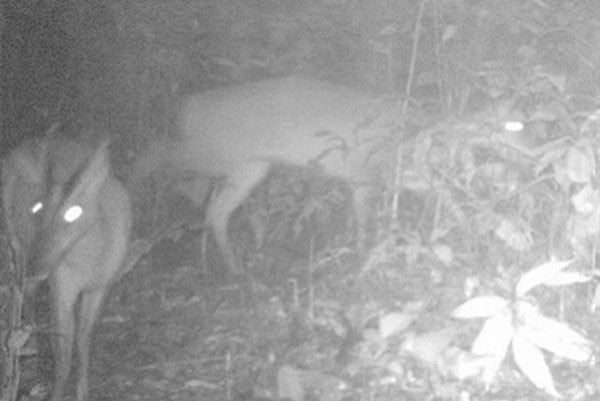Detecting populations of rare Muntiacus rooseveltorum
Scientists from Cress Center (Hanoi National University) in collaboration with officials of Xuan Lien Nature Reserve (Thuong Xuan district, Thanh Hoa province) have identified populations of Muntiacus rooseveltorum of deer family. (Cervidae) is considered extinct 84 years ago, there are about 30 individuals.
>>>Southeast Asian ungulate animals are on the verge of extinction
To determine the number of individuals Carrying on in Xuan Lien Nature Reserve, scientists have used camera trapping methods in areas where this deer hooves often appear and at points near the river, heating. After the follow-up period, the scientists determined that there were only about 30 individuals carrying Muntiacus rooseveltorum .

Two individuals Carry Muntiacus rooseveltorum.(Photo: Trinh Duy Hung / Vietnam + )
The identification of this number of individuals carries important implications for the conservation, breeding, and storage of genetic resources of the Rare Mangrove species once considered extinct. At present, the forest protection force of Xuan Lien Nature Reserve is promoting propaganda to people living in the area on the protection of this rare species. Earlier, some households did not know how to hunt this rare species of Mang.
From 2012-14, Cress Center collaborated with staff of Xuan Lien Nature Reserve to implement the project "Investigation and Conservation of Mangrove Species in Xuan Lien Nature Reserve". During the investigation, the team captured the image of this species in Xuan Lien Nature Reserve and discovered the specimen of this species in the forest. In addition, the team also found samples of this species of horn and skin in the hunting house.
Through DNA testing at the Institute of Biological Resources and Biology (Vietnam Academy of Science and Technology) from the specimen and skin samples of the species mentioned above and compared to the DNA model of the Mangrove species considered to be extinct. Here 84 years are kept at the Museum of Natural History in the United States, which identifies perfectly matched DNA patterns and affirms that this is the extinct Muntiacus rooseveltorum species 84 years ago, now reappears.
The title has been changed.
- Species of extinct animals suddenly appeared in Thanh Hoa
- Large species of rare species found in Sao La conservation area
- Approaching a population of 9,000 emperor penguins
- Detecting populations of rare and precious conifer trees
- Discovering rare and precious species in Thanh Hoa
- Detecting microbial populations in places without oxygen and light
- Detecting rare and precious snub-nosed monkeys in Ha Giang
- The world's rivers and lakes have lost nearly 90% of large species
- For the first time, discovering big Mang in Quang Nam
- Appeared Stonehenge relics populations on Mars?
- Vietnam: Detecting a new, rare dragonfly
- China found 60 dinosaur populations
 Animal 'suffering' after hibernation
Animal 'suffering' after hibernation Why do goats climb well?
Why do goats climb well? Scientists were surprised to see chimpanzees eating turtles
Scientists were surprised to see chimpanzees eating turtles Giant catfish died deadly due to drought in Thailand
Giant catfish died deadly due to drought in Thailand